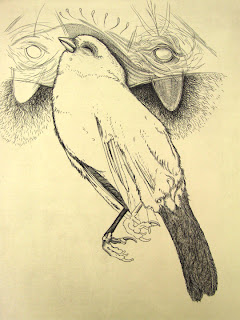Monday, November 19, 2012
Oscar's return visit
Oscar has decided to incorporate two more plates into his engraving, so he is back home in Peroria completing the mezzotints that will carry the lush colors (looking forward to the Oscar Red). He'll return on December 1 and 2 for a print-a-thon in the shop with the usual band of Rolling Knob Press printers. We're all pretty excited about that. We learned so much while he was here, so everyone is working on engravings and mezzotint collagraphs to keep the momentum going. Thanks, Oscar, and we'll see you in a few weeks.
Thursday, November 15, 2012
Oscar Gillespie's Visit
Oscar has been working in the shop all week, cutting away on a large zinc plate that's polished to a jeweler's perfection. He's also taught my students how to engrave and many are cutting away on their plates. Yesterday he presented his work and influences to about 50 students and faculty. It's been a busy week so far.
Engraving is the practice of incising a design on to a hard, usually flat surface, by cutting grooves into it. The result may provide an intaglio printing plate line work for printing images on paper as prints; these images are called engravings.
Engraving was a historically important method of producing images on paper, both in artistic printmaking, and also for commercial reproductions and illustrations for books and magazines. Partly because of the difficulty of learning the technique, is much less common in printmaking today. However, traditional engraving, by hand with a burin, continues to be practised by goldsmiths, glass engravers, gunsmiths, and Oscar Gillespie!
Oscar is preparing copper plates to so that color can be added to the engraving he's been working on. The proof below is where the plate was yesterday afternoon, but there has been a lot more cutting since then so I suspect that it's much more lush with Oscar's distinctive line work.
Engraving is the practice of incising a design on to a hard, usually flat surface, by cutting grooves into it. The result may provide an intaglio printing plate line work for printing images on paper as prints; these images are called engravings.
Engraving was a historically important method of producing images on paper, both in artistic printmaking, and also for commercial reproductions and illustrations for books and magazines. Partly because of the difficulty of learning the technique, is much less common in printmaking today. However, traditional engraving, by hand with a burin, continues to be practised by goldsmiths, glass engravers, gunsmiths, and Oscar Gillespie!
The works below are examples of Oscar Gillespie's print work that he has shown to numerous students and faculty during his visit. These are only a few of the many prints he brought with him to share.
This engraving with aquatint (maybe even some mezzotint) has the intense "Oscar-Red" that adds a very unique quality to his work.
The above reductive relief print was a demonstration impression that Oscar created for his students. I was glad that he brought it with him as my beginning students are currently working on relief prints, so seeing other possibilities other than simply black and white was good for them to experience.
This is one of a series of circular engravings created by Oscar, the fluidity of the line work is amazing.
Check back later to see the final impression.
Monday, November 5, 2012
Oscar Gillespie Rolling Knob Visiting Printmaker
Oscar J. Gillespie is a Professor of Art at Bradley University, where he has been a member of the faculty since January of 1986. He teaches printmaking and drawing. As a printmaker, he is noted for his expertise in monotypes and in intaglio, especially metal-plate engraving.
Born in Arizona in 1952 and raised in Holbrook near the Navajo Reservation, he holds an M.F.A. degree in Printmaking from Arizona State University (1983), and a B.F.A. in Printmaking from Northern Arizona University (1977).
From 1986 to 1991 he directed three biennial Bradley National Print and Drawing Exhibitions. Since 1991, he has guided Bradley’s Cradle Oak Press as Printer and Coordinator for a program that invites noted artists to campus for the purpose of collaborating with faculty and students in the creation and publishing of hand-printed editions.
Exhibiting widely since 1974, he has shown his work in more than 300 solo, group, invitational and juried exhibitions. His work may be found in more than 60 public collections, including the Fogg Museum, Harvard; The Museum of Fine Arts, Boston; the Denver Art Museum; the Lauren Rogers Museum, Laurel, Mississippi; the Walker Art Center, Minneapolis; the Nelson-Atkins Museum, Kansas City, the New York Public Library; the Plains Museum, Fargo, North Dakota; and the National Museum of Posnan, Poland.
Born in Arizona in 1952 and raised in Holbrook near the Navajo Reservation, he holds an M.F.A. degree in Printmaking from Arizona State University (1983), and a B.F.A. in Printmaking from Northern Arizona University (1977).
From 1986 to 1991 he directed three biennial Bradley National Print and Drawing Exhibitions. Since 1991, he has guided Bradley’s Cradle Oak Press as Printer and Coordinator for a program that invites noted artists to campus for the purpose of collaborating with faculty and students in the creation and publishing of hand-printed editions.
Exhibiting widely since 1974, he has shown his work in more than 300 solo, group, invitational and juried exhibitions. His work may be found in more than 60 public collections, including the Fogg Museum, Harvard; The Museum of Fine Arts, Boston; the Denver Art Museum; the Lauren Rogers Museum, Laurel, Mississippi; the Walker Art Center, Minneapolis; the Nelson-Atkins Museum, Kansas City, the New York Public Library; the Plains Museum, Fargo, North Dakota; and the National Museum of Posnan, Poland.
Subscribe to:
Comments (Atom)







